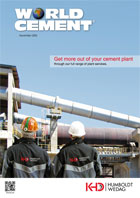Editorial comment
What does your network look like and what does it mean to you? If I had the space to draw you a picture of my network, I imagine it would look less like a spider diagram and more like many spiders roped together climbing Mount Everest. There is me, my immediate colleagues here at Palladian Publications, the readers of World Cement, our authors, advertisers, technical advisors, institutions, contacts passed on to me by industry experts – the list is seemingly endless and that is without accounting for my life outside of work! A network of that sort takes time to build up, it takes work to maintain, and it is constantly evolving. It is also essential in order for me to do my job.
Register for free »
Get started now for absolutely FREE, no credit card required.
Though the internet could never replace face-to-face interaction, the rise of social networking is making the construction, maintenance and expansion of your network that bit easier. Take LinkedIn as an example. In the beginning, LinkedIn was seen by many as a kind of online CV-builder that would help you to make new business connections that might lead to new employment opportunities. Now, though, through the ‘interests’ function, you can join groups that relate specifically to your areas of interest and immediately gain access to a network of likeminded individuals who can aid both your personal and professional development. For newcomers to the industry, joining an interest group and participating in discussions can be an instant means of building a network that could otherwise take years. For more experienced members of the industry, the network could be viewed as a means of skills transference in an industry that is facing a severe skills shortage. Participation is key, though. Networking is a two-way street.
In the article beginning on page 95 of this bumper issue, Kathryn Bellamy and Kevin Rudd also take up the topic of network-building. Kevin has recently been elected as a Fellow of the Institution of Mechanical Engineers and has taken it upon himself to create a network through the Institution that could preserve the knowledge and expertise of engineers. Kevin has already visited a couple of cement plants and reports a positive response: “it was as if we were pushing an open door to try and connect to others regarding technical issues and innovations”. Indeed, for those working in the cement industry but in smaller companies rather than multinational corporations, such a network could prove essential to building up a core of expertise.
World Cement has a LinkedIn group. Why not join up, expand your network and take the opportunity to discuss this comment or Kevin’s article and tell us about your network. Of course, while you’re there, you can also find links to our Twitter feed, Facebook page and new Google+ community – or feel free to email me for details.


